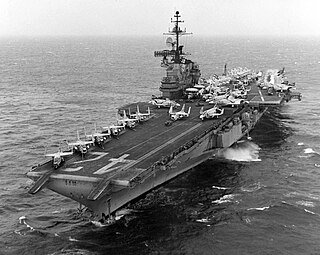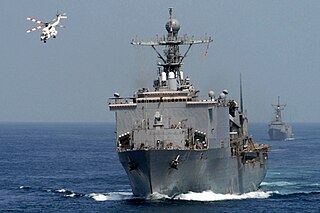
The San Antonio class is a class of amphibious transport docks, also called a "landing platform, dock" (LPD), used by the United States Navy. These warships replace the Austin-class LPDs, as well as the Newport-class tank landing ships, the Anchorage-class dock landing ships, and the Charleston-class amphibious cargo ships that have already been retired.

An amphibious transport dock, also called a landing platform dock (LPD), is an amphibious warfare ship, a warship that embarks, transports, and lands elements of a landing force for expeditionary warfare missions. Several navies currently operate this kind of ship. The ships are generally designed to transport troops into a war zone by sea, primarily using landing craft, although invariably they also have the capability to operate transport helicopters.

USS New Orleans (LPD-18), a San Antonio-class amphibious transport dock, is the fourth commissioned ship of the United States Navy to be named after the city of New Orleans, Louisiana.

USS Franklin D. Roosevelt (CVB/CVA/CV-42) was the second of three Midway-class aircraft carriers. To her crew, she was known as "Swanky Franky," "Foo-De-Roo," or "Rosie," with the last nickname probably the most popular. Roosevelt spent most of her active deployed career operating in the Mediterranean Sea as part of the United States Sixth Fleet. The ship was decommissioned in 1977 and was scrapped shortly afterward. She was the first aircraft carrier of the United States Navy to be named in honor of a president of the United States.

A dock landing ship is an amphibious warfare ship with a well dock to transport and launch landing craft and amphibious vehicles. Some ships with well decks, such as the Soviet Ivan Rogov class, also have bow doors to enable them to deliver vehicles directly onto a beach. Modern dock landing ships also operate helicopters.

Joint Expeditionary Base–Little Creek (JEB–LC), formerly known as Naval Amphibious Base Little Creek and commonly called simply Little Creek, is the major operating base for the Amphibious Forces in the United States Navy's Atlantic Fleet. The base comprises four locations in three states, including almost 12,000 acres (4,900 ha) of real estate. Its Little Creek location in Virginia Beach, Virginia, totals 2,120 acres (860 ha) of land. Outlying facilities include 350 acres (140 ha) located just north of Training Support Center Hampton Roads in Virginia Beach and 21 acres (8.5 ha) known as Radio Island at Morehead City, North Carolina, used for U.S. Coast Guard ships and personnel as well as serves as an amphibious embarkation/debarkation area for U.S. Marine Corps units at Marine Corps Base Camp Lejeune, North Carolina. It is also home to the Naval School of Music.
The names of commissioned ships of the United States Navy all start with USS, for United States Ship. Non-commissioned, primarily civilian-crewed vessels of the U.S. Navy under the Military Sealift Command have names that begin with USNS, standing for United States Naval Ship. A letter-based hull classification symbol is used to designate a vessel's type. The names of ships are selected by the Secretary of the Navy. The names are those of states, cities, towns, important persons, important locations, famous battles, fish, and ideals. Usually, different types of ships have names originated from different types of sources.

USS Whidbey Island (LSD-41) is a Whidbey Island-class dock landing ship (LSD) of the United States Navy. She was named for Whidbey Island, in Puget Sound, Washington, the location of NAS Whidbey Island; the name ultimately derives from the sailor, explorer and engineer Joseph Whidbey.

USS Fort McHenry (LSD-43) is a Whidbey Island-class dock landing ship of the United States Navy. She was named for Fort McHenry, in Baltimore, Maryland, the 1814 defense of which inspired "The Star-Spangled Banner".

USS Gunston Hall (LSD-44) is a Whidbey Island-class dock landing ship of the United States Navy. She was the second Navy ship to be named for Gunston Hall, the Mason Neck, Virginia, estate of George Mason, one of Virginia's Revolutionary figures, and "Father of the Bill of Rights". Gunston Hall was laid down on 26 May 1986, at the Avondale Shipyards, New Orleans. The ship was launched on 27 June 1987, commissioned on 22 April 1989 and assigned to Naval Amphibious Base Little Creek.

USS Tortuga (LSD-46) is a Whidbey Island-class dock landing ship of the United States Navy. She was the second Navy ship to be named for the Dry Tortugas, a group of desert coral islets 60 miles (97 km) west of Key West, Florida.

USS Rushmore (LSD-47) is a Whidbey Island-class dock landing ship of the United States Navy. She was the second navy ship to be named for the Mount Rushmore National Memorial in the Black Hills of South Dakota. She is the seventh ship in her class of dock landing ships and the fourth ship in that class to serve in the United States Pacific Fleet.
A joint support ship (JSS) is a multi-role naval vessel capable of launching and supporting joint amphibious and airlift operations. It can also provide command and control, sealift and seabasing, underway replenishment, disaster relief and logistics capabilities for combined land and sea operations.

The Harpers Ferry class of the United States Navy is a class of dock landing ships completed in the early 1990s. Modified from the Whidbey Island class, the design sacrifices landing craft capacity for more cargo space, making it closer to an amphibious transport dock type, but was not designated as such. Externally, the two classes can be distinguished by the positions of weapons: The Harpers Ferry class has the Phalanx CIWS mounted forward, and the RAM launcher on top of the bridge, while the Whidbey Island has the opposite arrangement.
Tortuga is the Spanish word for a turtle or tortoise. It may also refer to:

The Anchorage-class dock landing ships were a series of five dock landing ships (LSD) constructed and commissioned by the United States Navy between 1965 and 1972. US Navy decommissioned all five of them by 2003. They are succeeded by Whidbey Island-class LSDs and Harpers Ferry-class LSDs.

The Ashland-class dock landing ship were the first class of dock landing ship of the United States Navy. They were built during World War II. A dock landing ship is a form of auxiliary warship designed to support amphibious operations. Eight ships were built for the United States Navy and they remained in US service until the 1960s. Two of the class were sold for export overseas, with one joining the Republic of China Navy and the other the Argentinian Navy. The two transferred ships stayed in service until the 1980s. All eight ships were scrapped.















